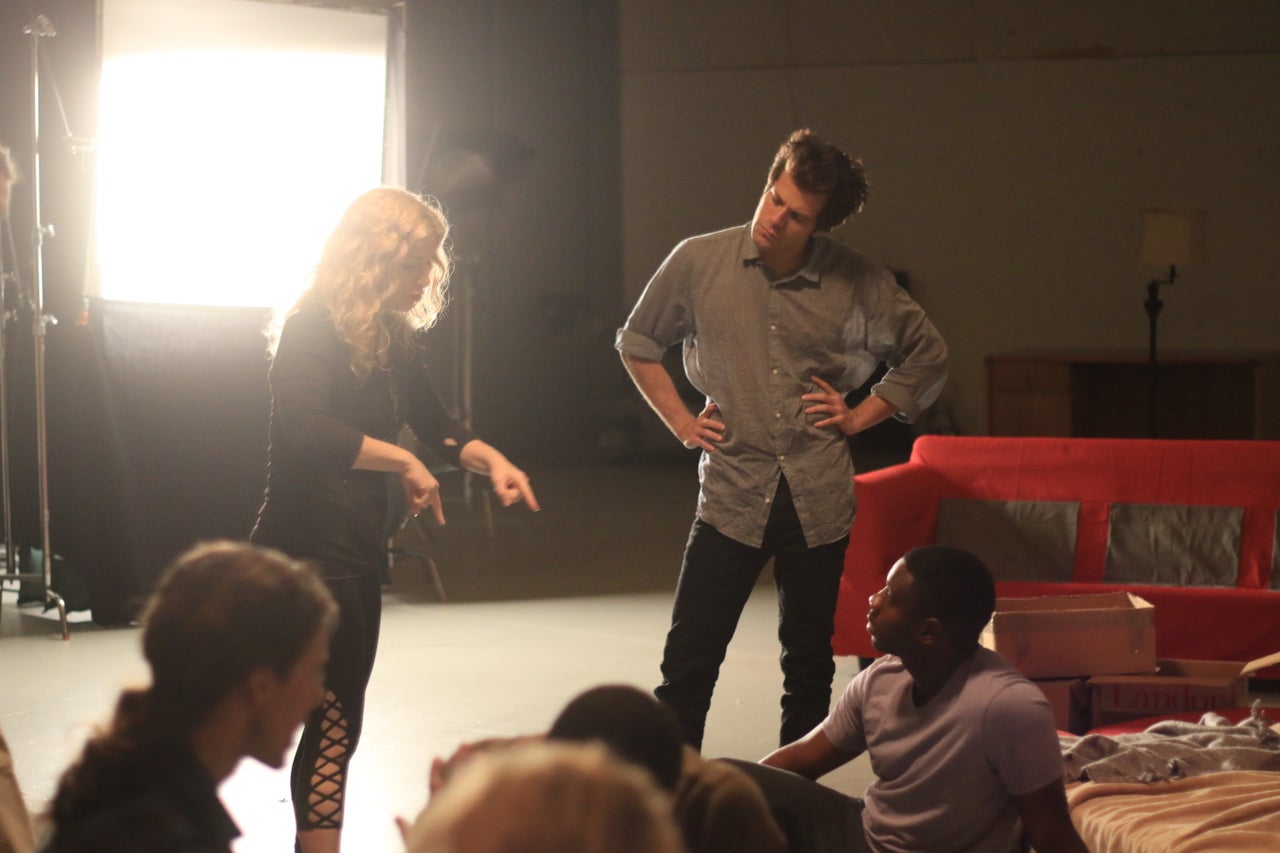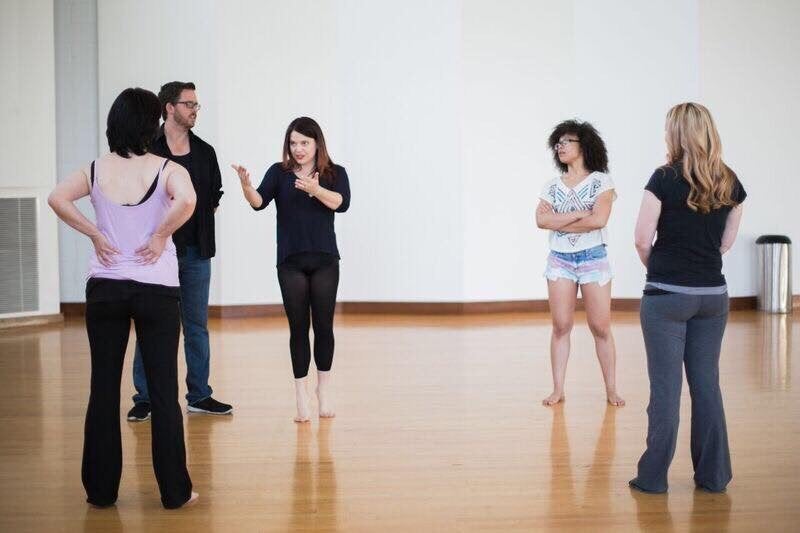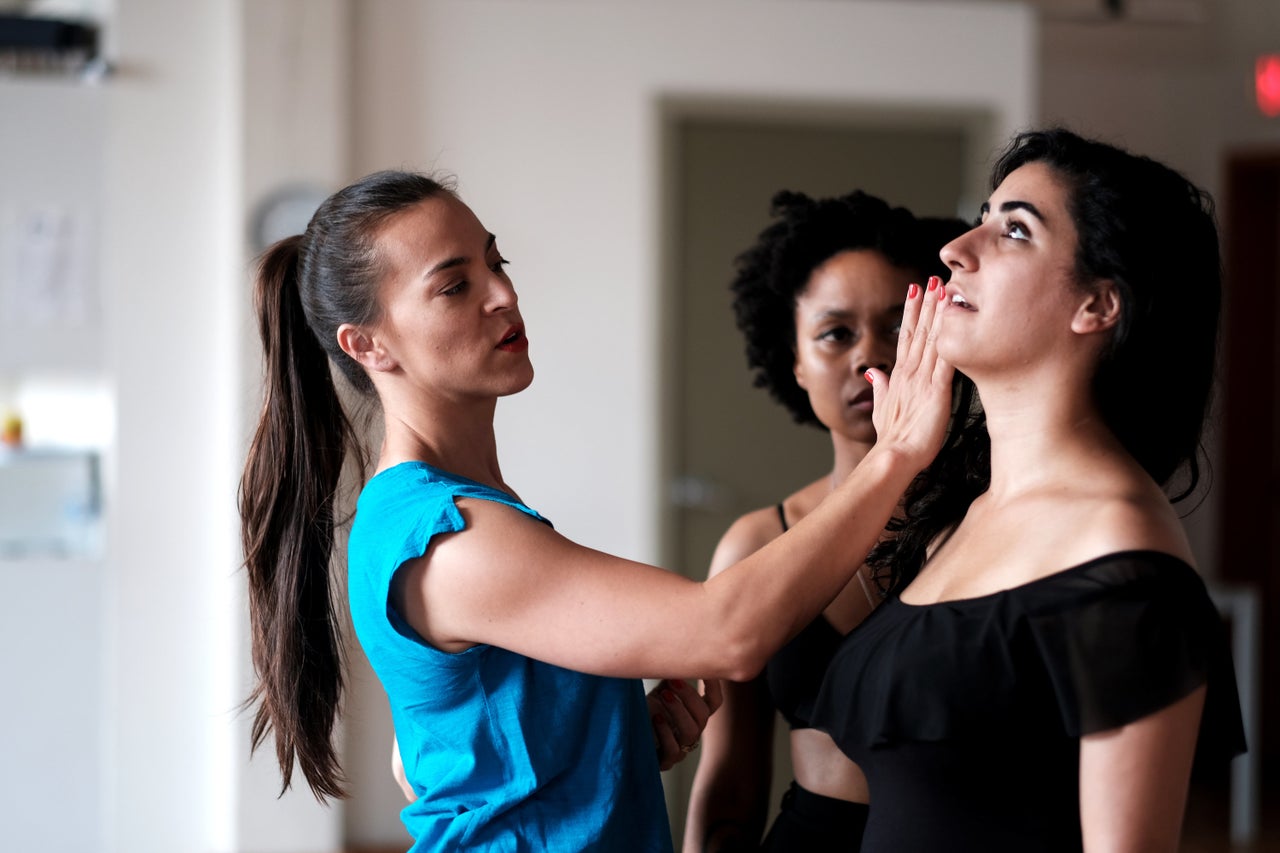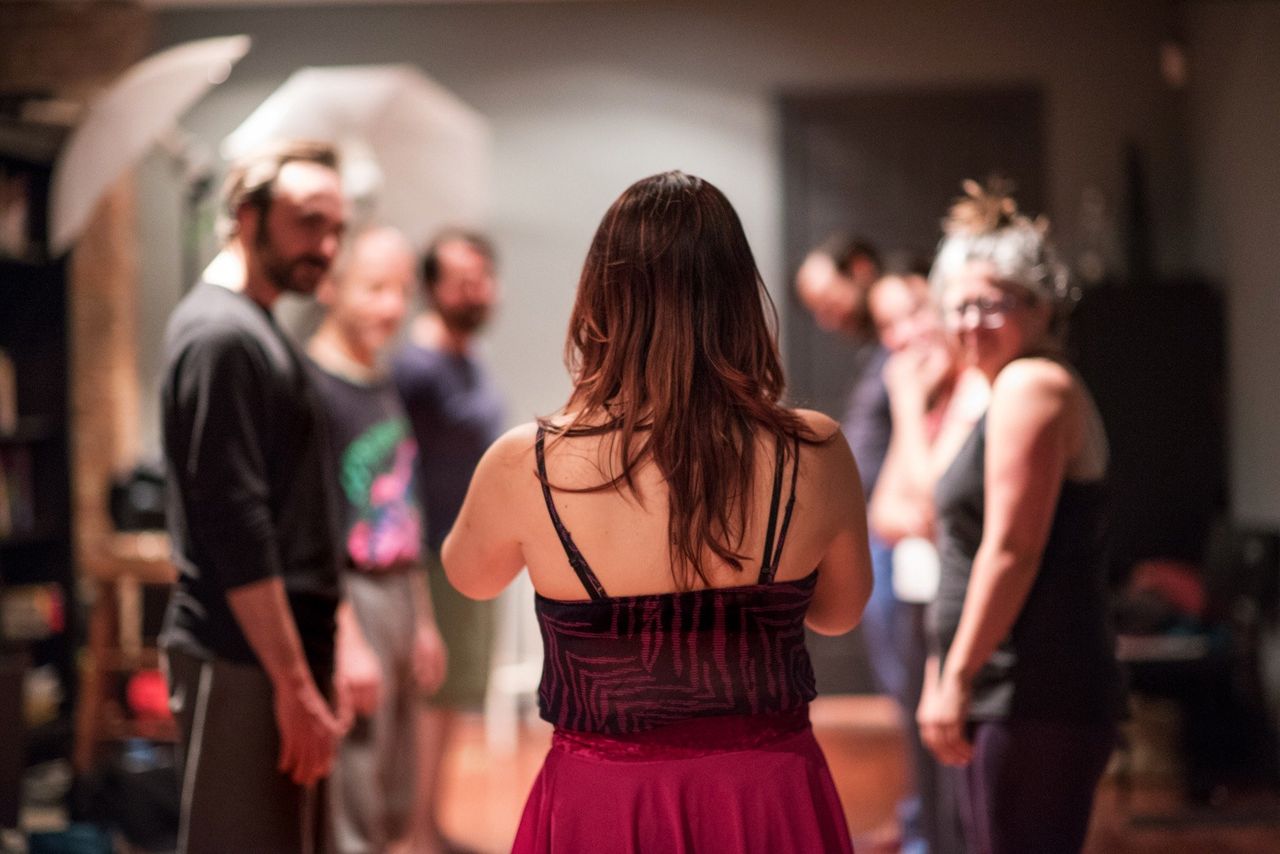Alicia Rodis had her first kiss on stage when she was 15. She faked her first orgasm on stage too, when she was 18 ― the same year she first appeared nude in a production.
“I never looked like an ingenue,” she said. “I developed early, so if there was a prostitute or a slutty best friend in a play who had that reputation, that’s probably who I was playing.”
As an aspiring actress, Rodis was happy to take the roles she was offered, including those that required engaging in and acting out intimate scenes with strangers. But the power dynamics between a young actress and director, paired with the potential for miscommunication between actors portraying scenes of sexual intimacy, meant she was vulnerable to misconduct.
“I had some experiences that were really wonderful, and I had some experiences that were downright dangerous,” she said. “Even if not physically dangerous, then mentally and emotionally harmful.”
Rodis eventually became a fight and stunt director based in New York, helping stage and film productions choreograph violent scenes in a way that ensured actors remained safe and unharmed.
Union standards require productions to hire fight directors to choreograph scenes of sexual violence, but Rodis wondered why similar protocols and procedures didn’t exist for staged moments of romantic sexual intimacy ― which can be clumsily executed at best and invite inappropriate behavior at worst.
“I was working on a show and I was there for a slap and a kiss,” Rodis recalled. “We choreographed the slap and it was fine, then we got to the kiss and the actors were just terrified.”
The actors asked Rodis to step in, and they went over one another’s respective boundaries and determined how physical moments should move the story forward. “After that, it looked beautiful,” she said.

Rodis was practicing intimacy direction, an emerging field in which a small group of professionals are pushing to develop standards and procedures for scenes involving physical intimacy in the wake of a public reckoning with sexual misconduct throughout the entertainment industry.
Intimacy directors or choreographers are hired to facilitate scenes for the stage and screen involving physical touch, from moments of sexual tension to scenes featuring nudity and simulated sex and even familial intimacy. In many cases, an intimacy director’s most important role is their most passive: They are the person in the room whose job it is to discuss and understand an actors comfort with various aspects and types of touch in scenes of physical intimacy.
If an actor or director deviates from the predetermined choreography, an intimacy director can intervene, relieving performers themselves of the fraught responsibility to confront one another about a drifting hand, or to challenge a director pushing for more contact or nudity than previously agreed upon.
“When you’re doing a fall, you ask for a mat. We don’t want to break the actor. Well, we don’t want to break the actor emotionally or psychologically either."”
- Claire Warden
Tonia Sina of Oklahoma City developed intimacy direction as a discipline in a graduate thesis 15 years ago. She’d found that for a director to simply ask performers to do what they feel ― to touch one another however they are moved to ― “led to a lot of mishandling and really horrible situations to be put in as a young actress,” she said.
In 2016, Sina and Rodis founded Intimacy Directors International with Siobhan Richardson, an actor and fight director in Canada. Claire Warden, who’s based in New York, joined later. They’d all found that choreographing intimate moments could prevent the type of ambiguity and miscommunication that can give way to misconduct.
All four women said they had either experienced inappropriate behavior themselves on sets or witnessed mishandling of scenes involving physical touch.
“I’ve been in the situation myself, where you’re thinking, ‘That hand seems to be drifting, but should I say something?’ It’s difficult to bring that kind of thing up,” Warden told HuffPost. “Even if you do, even if you are brave enough to say, ‘Hey, you put your hand on my butt,’ they’ll say, ‘Oh, I was just in the moment, I was really feeling it,’ which is how a lot of abuse can be covered up.”
By founding an official association of professionals, Richardson, Sina, Rodis and Warden hope to standardize protocols and procedures and further develop the discipline at a moment when awareness of sexual misconduct on the stage and screen is at an all-time high.
“When you have a profession where people have to touch each other at their job, there need to be rules around that,” Sina said.

After revelations of film producer Harvey Weinstein’s history of abuse and as the Times Up and Me Too movements rippled through the industry more broadly, more people who make films have been open to hiring a specialized professional to work out sex scenes with performers.
But Sina said it was President Donald Trump’s election ― amid allegations that he had sexually assaulted multiple women ― that “really made our phone ring off the hook.”
“It made people more aware that they maybe in the past have overstepped some lines, and that they need re-examine the way they’re approaching their work,” she said.
The theater world had begun to confront the potential for abuse in 2016. That year, an exposé revealed that Chicago’s Profiles Theater, which for decades was lauded for its raw, edgy performances involving nudity and sexually explicit content, had permitted rampant sexual abuse and violence on its stage. Violent acts that audience members assumed were choreographed to avoid physical harm were, instead, on-stage beatings and sexual assaults.
Profiles Theater closed permanently in 2016.

“Every actor I have spoken to about this, and I’ve spoken to hundreds, male or female or gender fluid, has a story being in a moment of intimacy and having a negative experience, ranging from uncomfortable to traumatizing,” Warden said.
She added that unease with talking about sex, and what it ought to look like, often means directors fail to set the terms for intimate scenes.
“A large amount of it is just from discomfort with having a conversation and not quite knowing how to handle it, and just saying, ‘Great, just grab her there and put that there,’” she said. “That, in any other situation, is sexual assault.”
“Stage sex is nothing like real sex. It’s fake. It has to be taught, and it has to be choreographed separately."”
- Tonia Sina
But there are other reasons why directors might avoid discussing the mechanics of an intimate scene before it is filmed or performed. Most commonly, they may not want to dampen the actors’ authentic response to intimate touch with choreographed passion.
Intimacy directors say the opposite is typically true: Without clear direction, actors are left to fumble through scenes with no knowledge of each other’s boundaries, or more practically, how the moment should contribute to the story being told.
“Stage sex is nothing like real sex. It’s fake. It has to be taught, and it has to be choreographed separately,” Sina said. “There shouldn’t be any grey area.”
Any grey area that results from failing to set the terms beforehand creates “a huge capacity for the possibility of harassment” Rodis said, especially if one actor’s “authentic response” crosses their stage partner’s boundaries, or if a director makes a spontaneous change that goes beyond the terms of someone’s nudity rider.
“The power dynamic is so strong in these situations. You’re on a time crunch. There’s so much money involved ― it’s tough to advocate for yourself,” Rodis said.
Richardson said she believes that choreographing intimate scenes gives her and performers the tools to address spontaneous variations objectively.
“If one actor thinks, ‘This doesn’t feel right, I’m going to grab a little harder today,’ I can jump in and say, ‘Well, that’s not part of the agreement. That’s not part of the text,‘” she said. “So we’re trying to move away from the culture of ‘We’ll just figure it out as we go’ to choreographing intimacy like we choreograph everything else.”

Intimacy directors also train in mental health first aid in order to pick up on actors’ physical signs of discomfort or unease, and intervene before lines are crossed even further. Warden told HuffPost that fight scenes and those involving intimate, physical touch can be uniquely similar in their psychological impact on those performing them.
“Our psyches have an enormously difficult time differentiating between real and staged violence, even if no contact is made. It’s the same with this. It becomes real in the moment,” she said, comparing intimacy direction to the precautions taken to avoid physical injury in cases of staged fighting.
“You have equipment you work with so you don’t get hurt,” Warden said. “When you’re doing a fall, you ask for a mat. We don’t want to break the actor. Well, we don’t want to break the actor emotionally or psychologically either.”
She added, “I liken it to a jungle gym. If you build a really solid jungle gym and you know where all the bars are you, you can really leap because you know there’s something there to catch.”
Intimacy directors are currently more common in theatre than in film, though Rodis and Sina said they’ve been brought in to consult on network shows and feature movies in recent months. Sina said Intimacy Directors International is currently working with the Screen Actors Guild to standardize techniques and practices developed to prevent blurred lines and outright assault on film sets.
Rodis said directors appear more open to intimacy directors ― relieved to outsource the boundary-setting and tough conversations about consent to a specialized professional. She still encounters some discomfort with the idea, and emphasized that the role of intimacy directors is to improve conditions for the future, using the past to learn rather than incriminate.
“We are in this cultural shift where we all have to look at our own actions and what we have done in the past. It is very uncomfortable and scary to look back at another thing you worked on and think, ‘I’m not sure if I handled that right,’” she said.
“Now is about taking the opportunity of the cultural shift to look at the mirror and look at our past and say: ‘I didn’t know, but now I can educate myself and work better.’”
An earlier version of this story misspelled Siobhan Richardson’s first name.
